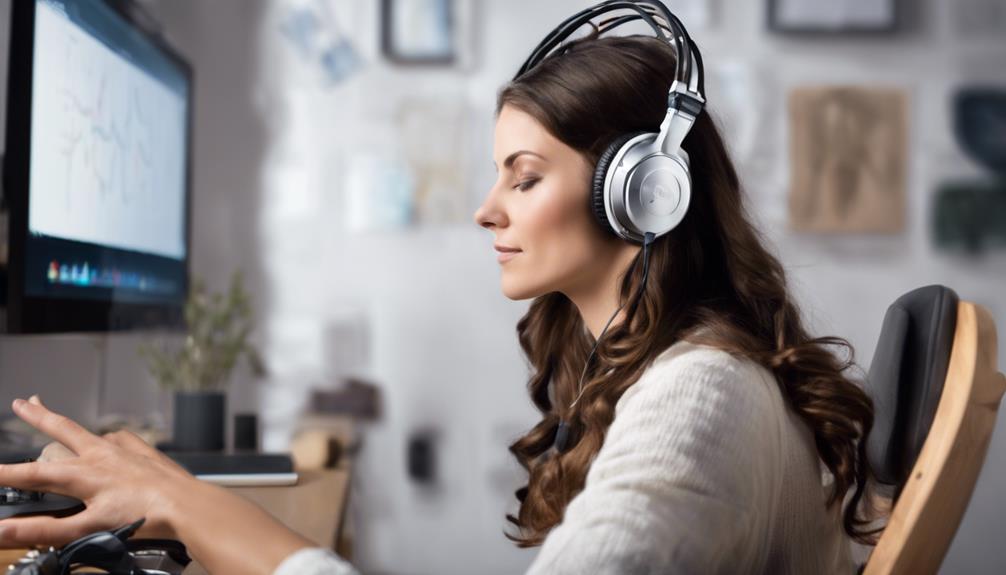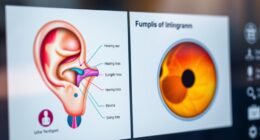Have you ever thought about the true effectiveness of auditory hallucinations therapy techniques?
Exploring various proven methods to manage and alleviate distress caused by auditory hallucinations is essential for improving overall well-being.
By understanding and incorporating these techniques into daily routines, individuals can take significant steps towards gaining control over their experiences and finding relief from the challenges posed by auditory hallucinations.
Key Takeaways
- Cognitive-Behavioral Therapy reduces auditory hallucination severity.
- Mindfulness practices enhance therapy outcomes.
- Family involvement improves support and understanding.
- Coping skills training fosters resilience and well-being.
Cognitive-Behavioral Therapy (CBT)
When considering therapies for managing auditory hallucinations, Cognitive-Behavioral Therapy (CBT) stands out as a proven and effective psychological intervention. In individuals with schizophrenia and other psychotic disorders, CBT has shown promising results in reducing the severity of auditory hallucinations. By focusing on changing the relationship with internal experiences, like voices, CBT equips individuals with coping strategies to address distress effectively. Tailored CBT approaches, such as Cognitive Therapy for Command Hallucinations, specifically target diminishing the perceived power of voices while enhancing the overall quality of life.
Research indicates that CBT not only reduces the severity of auditory hallucinations but also plays a significant role in improving psychosocial functioning. This tailored approach recognizes the unique needs of individuals experiencing auditory hallucinations and works towards sustainable benefits. By empowering individuals to navigate their internal experiences and develop practical coping mechanisms, CBT contributes positively to their overall well-being and quality of life.
Mindfulness Practices

Transitioning from Cognitive-Behavioral Therapy (CBT) to exploring Mindfulness Practices opens up new avenues for individuals to cultivate present-moment awareness and alleviate distress associated with auditory hallucinations. Incorporating mindfulness practices into therapy for auditory hallucinations can have a significant impact on well-being and daily life. Here are some key points to consider:
- Mindfulness practices combined with cognitive-behavioral strategies: By integrating mindfulness techniques with CBT, individuals can experience enhanced therapy outcomes, leading to improved distress and depression reduction related to auditory hallucinations.
- Adapted mindfulness for daily life impact reduction: Tailoring mindfulness practices to suit the individual's needs within therapy sessions can help in managing distress without requiring extensive practice outside of these sessions.
- Research-supported benefits: Studies have shown that mindfulness can effectively help individuals focus on the present moment, reducing the impact of auditory hallucinations on their daily lives while also improving overall well-being.
These findings highlight the importance of incorporating mindfulness practices in therapy to address auditory hallucinations effectively.
Acceptance and Commitment Therapy (ACT)
In exploring Acceptance and Commitment Therapy (ACT) for addressing auditory hallucinations, we focus on developing psychological flexibility and mindfulness skills. ACT, as a psychological intervention, emphasizes accepting internal experiences while committing to valued actions. This approach helps individuals navigate distressing auditory hallucinations by cultivating psychological flexibility and mindfulness.
Techniques such as cognitive defusion, acceptance, and values clarification are employed to shift the relationship with voices and reduce suffering. By incorporating ACT into therapy, individuals can work towards reducing the impact of auditory hallucinations on daily functioning and enhancing overall quality of life.
Research indicates that ACT can effectively enhance resilience in individuals experiencing auditory hallucinations. Embracing ACT in the treatment plan offers a path towards greater acceptance of internal experiences and empowers individuals to engage in actions aligned with their values, ultimately fostering a sense of well-being amidst the challenges posed by auditory hallucinations.
Dialectical Behavior Therapy (DBT)

As we shift our focus to Dialectical Behavior Therapy (DBT) for addressing auditory hallucinations, we encounter a structured approach designed to enhance coping skills, regulate emotions, and improve interpersonal effectiveness in individuals experiencing distressing voices. DBT incorporates mindfulness practices, distress tolerance techniques, and emotion regulation strategies to help individuals manage distressing voices. This therapy targets both the symptoms of auditory hallucinations and the emotional distress associated with hearing voices, offering a comprehensive approach to addressing these challenges.
Research supports the effectiveness of DBT in reducing auditory hallucination severity and improving overall well-being in individuals with psychotic disorders. By utilizing DBT interventions, individuals can build resilience and improve their quality of life by learning to navigate their auditory hallucinations with greater ease and control. This evidence-based approach provides a supportive framework for individuals to develop the necessary skills to cope with and manage the impact of auditory hallucinations on their daily lives.
Family Therapy
Family therapy integrates the involvement of family members to enhance support and understanding for individuals grappling with auditory hallucinations. This form of therapy focuses on improving communication, reducing stigma, and addressing family dynamics that may impact the individual's experience. By involving family members, therapy aims to strengthen relationships, educate on hallucinations, and create a supportive environment. Through this collaborative approach, better treatment outcomes, increased adherence to interventions, and overall improved well-being for the individual can be achieved. Addressing family dynamics and fostering a supportive environment are crucial aspects of comprehensive treatment for auditory hallucinations.
| Benefits of Family Therapy | Description | Example |
|---|---|---|
| Enhanced Support | Involving family members provides a strong support system for the individual. | Family attending therapy sessions together. |
| Improved Communication | Family therapy helps in enhancing communication within the family unit. | Learning active listening techniques. |
| Addressing Stigma | Therapy aids in reducing the stigma associated with auditory hallucinations. | Open discussions about myths and misconceptions. |
| Better Treatment Outcomes | Involving family members often leads to improved treatment results. | Decreased frequency of hallucinations post-therapy. |
Medication Management

Exploring medication management options is an integral aspect of comprehensive treatment for auditory hallucinations, especially in cases where family therapy has laid a foundation for support and understanding.
When considering medication for managing auditory hallucinations, there are several key points to keep in mind:
- Antipsychotic medications: These are frequently the first line of treatment for conditions like schizophrenia where auditory hallucinations are prominent.
- Clozapine: This specific antipsychotic has shown effectiveness in treating chronic auditory hallucinations but may come with serious side effects that require careful monitoring.
- Psychotropic drugs: Alongside neuroleptics, these medications are utilized to alleviate symptoms of auditory hallucinations by targeting neurotransmitter imbalances and brain network activation associated with this condition.
Collaboration with healthcare providers is crucial in navigating the complexities of psychiatric medication, ensuring the best possible outcomes while managing potential side effects effectively in the treatment of auditory hallucinations.
Reality Testing Techniques

When it comes to managing auditory hallucinations, reality testing techniques play a crucial role in our therapeutic journey.
By questioning the accuracy of what we hear and comparing it to the real world, we can begin to distinguish between what's truly happening and what's a creation of our minds.
Through reality testing, we can start unraveling the mystery behind our auditory hallucinations and take steps towards regaining control.
Hallucination Identification Methods
Utilizing reality testing techniques in therapy offers individuals experiencing auditory hallucinations a practical approach to questioning and discerning the authenticity of their perceptions, ultimately aiding in improved management of their experiences.
When identifying hallucinations, consider the following:
- Recording voices: Use tools to assess accuracy and challenge validity.
- Logic of voices: Question consistency and logic to differentiate between hallucinations and reality.
- Awareness of triggers: Build awareness of triggers and patterns to effectively manage experiences.
Cognitive Distortion Recognition
Recognizing cognitive distortions through reality testing techniques empowers individuals to challenge and differentiate their thoughts related to auditory hallucinations, fostering enhanced coping mechanisms and improved management of their experiences.
By actively engaging in cognitive distortion recognition, individuals can confront distorted thoughts associated with auditory hallucinations and develop strategies to manage these experiences effectively.
Reality testing techniques encourage the challenging of beliefs by gathering evidence both for and against the hallucinatory perceptions, leading to a more balanced perspective. This evidence-based approach enables individuals to regain control over their experiences, reduce distress, and diminish the impact of auditory hallucinations on their daily life.
Through the practice of reality testing, individuals can strengthen their ability to cope with auditory hallucinations and enhance their overall well-being.
Coping Strategies Development
In developing coping strategies through reality testing techniques, individuals can strengthen their ability to differentiate between auditory hallucinations and reality, ultimately empowering themselves to manage their experiences more effectively.
By engaging in reality testing, individuals can challenge the accuracy and credibility of auditory hallucinations, leading to a more grounded perception of reality. This process encourages critical thinking and rational evaluation of the content and context of auditory experiences, aiding in reducing distress and enhancing coping abilities.
Through therapy-focused development of reality testing skills, individuals can regain a sense of control over their perceptions and responses to auditory hallucinations, fostering a more balanced and manageable approach to dealing with such experiences.
Coping Skills Training

We understand that coping with auditory hallucinations can be overwhelming.
That's why learning coping skills is crucial for managing distressing voices.
Skill Building Activities
Engaging in skill-building activities empowers individuals experiencing auditory hallucinations to develop practical coping tools and enhance their quality of life. Coping skills training offers a structured approach to equip individuals with adaptive coping mechanisms, reducing the impact of distressing voices, and fostering resilience.
These activities encompass cognitive restructuring, relaxation techniques, reality testing, and assertiveness training. By participating in these skill-building exercises, individuals can regain a sense of control over their auditory hallucinations.
These strategies not only help in effectively dealing with the challenges posed by hallucinations but also aid in reducing their frequency, ultimately improving the individual's overall well-being and quality of life.
Stress Management Techniques
Practicing stress management techniques through coping skills training equips individuals with effective tools to manage auditory hallucinations and enhance their resilience in response to distressing voices. By incorporating relaxation techniques, mindfulness practices, and cognitive restructuring, individuals can develop adaptive coping mechanisms to address the challenges posed by auditory hallucinations. These strategies not only help in reducing the impact of distressing voices but also contribute to an overall improvement in the quality of life. Through coping skills training, individuals can regain a sense of control over their experiences, improving their ability to function daily. By focusing on stress management techniques, individuals can build resilience and cultivate a mindset that promotes well-being and adaptive responses to auditory hallucinations.
| Stress Management Techniques | Benefits | Implementation |
|---|---|---|
| Relaxation Techniques | Reduces stress levels | Deep breathing exercises |
| Mindfulness Practices | Increases awareness | Meditation |
| Cognitive Restructuring | Changes thought patterns | Challenging beliefs |
Social Support Interventions

Building a network of trusted individuals for emotional and practical support is a key component of social support interventions aimed at helping individuals cope with auditory hallucinations. Support groups provide a sense of community and understanding, reducing feelings of isolation and stigma.
Peer support from those with similar experiences enhances coping strategies and offers insights into managing auditory hallucinations effectively. By creating a safe space for sharing experiences, emotions, and challenges related to auditory hallucinations, social support interventions enable individuals to engage in social activities, connect with supportive peers, and enhance resilience.
These interventions not only reduce the impact of auditory hallucinations on daily functioning but also foster a sense of belonging and empowerment within a supportive community. With the right support network and coping mechanisms, individuals can navigate the challenges of auditory hallucinations with strength and determination.
Frequently Asked Questions
What Strategies Help With Auditory Hallucinations?
We've found that strategies like grounding techniques, deep breathing exercises, engaging in activities, practicing positive self-talk, and keeping a diary can be helpful in managing auditory hallucinations. These methods aim to redirect attention, promote relaxation, and counter negative thoughts associated with hallucinations.
Seeking support from healthcare professionals and support groups can also play a significant role in effectively managing auditory hallucinations.
What Is the Best Therapy for Auditory Hallucinations?
When it comes to managing auditory hallucinations, the best therapy often involves Cognitive Behavioral Therapy (CBT). CBT helps individuals challenge and change their beliefs about voices, reducing distress and improving coping strategies.
Research supports the efficacy of CBT in managing auditory hallucinations, including reducing the severity of command hallucinations.
What Are Grounding Techniques for Hallucinations?
When it comes to grounding techniques for hallucinations, staying present in the moment can be incredibly helpful. By focusing on our immediate surroundings, we can reduce distress and maintain a connection to reality.
Shifting our attention from auditory hallucinations to the tangible environment through techniques like deep breathing and sensory awareness can make a real difference.
Regular practice of grounding techniques is key to managing and coping with auditory hallucinations effectively.
What Is the First Line Treatment for Auditory Hallucinations?
When tackling auditory hallucinations, the initial step often involves antipsychotic medication. These medications are designed to address the neurochemical imbalances that contribute to auditory hallucinations.
Managing symptoms through medication is vital for lessening their impact. It's important to note that certain antipsychotics, like clozapine, can effectively treat chronic auditory hallucinations but may pose risks necessitating close monitoring.
Integrating psychological therapies like Cognitive Behavioral Therapy alongside medication can further optimize treatment outcomes.
Can Auditory Hallucinations Therapy Techniques Also Help with Auditory Processing Disorder?
Yes, auditory processing disorder therapy options can also be helpful in managing auditory hallucinations. Techniques such as auditory training, environmental modifications, and cognitive-behavioral therapy can improve overall auditory processing, which may alleviate some symptoms of auditory hallucinations in certain cases.
Conclusion
In conclusion, utilizing these auditory hallucinations therapy techniques can greatly improve our ability to cope with distressing voices. Remember, we have the power to take control of our mental health and find the support we need to navigate this challenging experience.
By incorporating these strategies into our daily routines, we can create a sense of empowerment and resilience that will help us thrive in the face of adversity. Remember, with determination and practice, we can conquer even the loudest of voices in our minds.











